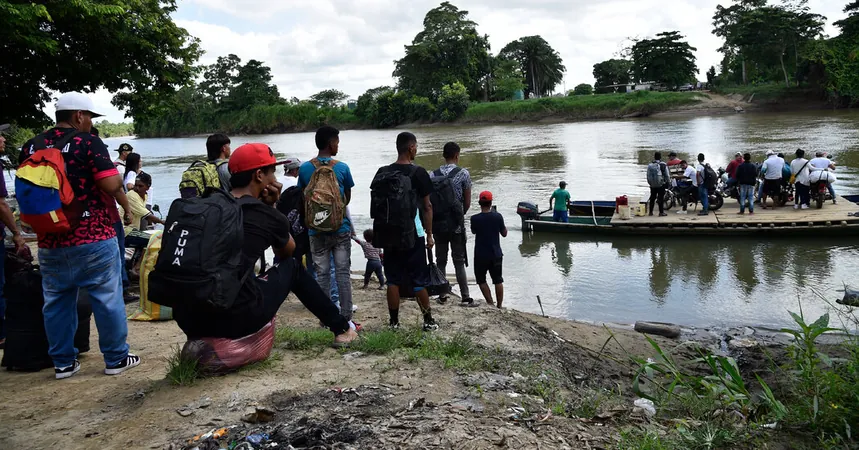
Catastrophic Violence in Colombia Claims 80 Lives; Over 18,000 Displaced Amid Escalating Armed Conflict
2025-01-20
Author: Ling
Escalation of Violence in Catatumbo
In a shocking escalation of violence, at least 80 individuals have lost their lives, and more than 18,000 people have been forced to flee their homes in Colombia due to fierce confrontations between rival armed groups along the border with Venezuela.
This brutal onslaught, which has unfolded over the last four days in the northeastern region of Catatumbo, marks one of the deadliest upticks in violence the country has faced in years, casting doubt on the potential for lasting peace in a nation striving for tranquility since the historic 2016 peace agreement with the Revolutionary Armed Forces of Colombia (FARC).
Government Response
President Gustavo Petro, who has championed the "total peace" initiative during his presidency, visited the strife-torn region. He expressed solidarity with the people of Catatumbo through a post on X, promising both military reinforcements and humanitarian aid.
Displaced families have sought shelter in makeshift refugee areas, including a stadium in Cúcuta—an area known for accommodating Venezuelan migrants escaping their own country's crises.
Historical Context of Violence
The escalating violence in Catatumbo has starkly contrasted with the wave of hope that followed the FARC peace deal less than a decade ago. For decades, Colombia's internal conflict saw the government, right-wing paramilitary forces, and various leftist groups, like the FARC and the National Liberation Army (ELN), struggle for power and control over lucrative drug-trafficking routes.
Fragmented Factions
While thousands of FARC combatants accepted disarmament, peace has remained elusive as fragmented factions, including the ELN and breakaway groups from FARC, vie for control over cocaine-producing territories.
Catatumbo, particularly notorious for its expansive coca plantations, has become a battleground for these power struggles.
Military Tensions
General Luis Emilio Cardozo, head of the Colombian army, revealed that a recent breakdown of a fragile truce between the ELN and a faction of former FARC members known as the 33rd Front has intensified hostilities, with armed groups reportedly conducting door-to-door searches for former FARC combatants they wish to eliminate.
Evolution of the ELN
In a chilling confirmation of the violence, the ELN has acknowledged its focus on the 33rd Front in its recent communications.
This shift from revolutionary ideals toward brutal territorial disputes denotes a troubling evolution for the ELN, the oldest leftist guerrilla group in Latin America, which had once positioned itself as a advocate for the impoverished.
Increased ELN Presence
In a revealing statistic, the ELN's footprint has expanded across Colombia; in 2019 it maintained a presence in 149 municipalities, which surged to 226 last year. Increasingly, its operations have extended into Venezuela, where the group finds refuge from Colombian military operations and a sympathetic ear in Venezuelan President Nicolás Maduro.
Broader Insecurity
In a separate area of concern, tensions have flared between former FARC factions in Guaviare region, pointing to a broader insecurity across the country.
Experts, including Elizabeth Dickinson from the International Crisis Group, have long warned about the potential for spontaneous eruptions of violence, emphasizing that the current situation represents a precarious tipping point for Colombia’s security.
Uncertain Path to Peace
As despair grows amid the ongoing violence in Catatumbo, Colombia's path to peace seems increasingly uncertain.
With existing armed groups becoming more violent and fractious and an apparent resurgence of conflict—from narcotrafficking struggles to internal power plays—the urgent need for a comprehensive and inclusive peace strategy has never been so critical.



 Brasil (PT)
Brasil (PT)
 Canada (EN)
Canada (EN)
 Chile (ES)
Chile (ES)
 Česko (CS)
Česko (CS)
 대한민국 (KO)
대한민국 (KO)
 España (ES)
España (ES)
 France (FR)
France (FR)
 Hong Kong (EN)
Hong Kong (EN)
 Italia (IT)
Italia (IT)
 日本 (JA)
日本 (JA)
 Magyarország (HU)
Magyarország (HU)
 Norge (NO)
Norge (NO)
 Polska (PL)
Polska (PL)
 Schweiz (DE)
Schweiz (DE)
 Singapore (EN)
Singapore (EN)
 Sverige (SV)
Sverige (SV)
 Suomi (FI)
Suomi (FI)
 Türkiye (TR)
Türkiye (TR)
 الإمارات العربية المتحدة (AR)
الإمارات العربية المتحدة (AR)